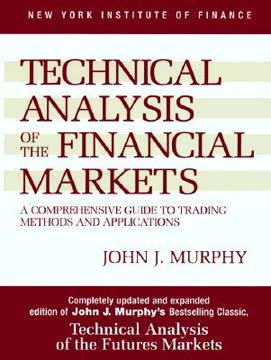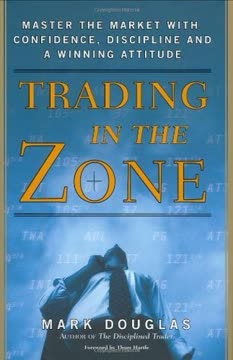Key Takeaways
1. Technical Analysis: Beyond Fundamentals
In many ways, there is no conflict between fundamental and technical analysis.
Two Sides of the Same Coin. Technical analysis focuses on price, volume, and open interest, while fundamental analysis examines supply, demand, and economic factors. Both approaches aim to understand market behavior, but they use different tools and perspectives. Technical analysis is self-contained, relying solely on market data, while fundamental analysis requires external information.
Timing is Key. Fundamental analysis may identify long-term trends, but technical analysis provides tools for timing entries and exits. Technical analysis is particularly useful in futures markets, where high leverage necessitates a focus on short-term price fluctuations.
Market Anticipation. Technical analysis assumes that the market reflects all known information, including the expectations of future events. This makes it a powerful tool for identifying recurring patterns and anticipating price movements.
2. Data is King: Understanding Averages and Distributions
The most prudent investor therefore, is one who pursues only a general course of action which is "normally" right and who avoids acts and policies which are—normally—wrong.
Averages are not enough. While averages provide a central tendency, they can be misleading without understanding the distribution of data. The arithmetic mean, geometric mean, and harmonic mean each have unique properties and are best suited for different types of data.
Distribution matters. Frequency distributions, medians, and modes help to understand the shape and extremes of price movement. Standard deviation measures the dispersion of data around the mean, while skewness and kurtosis quantify the asymmetry and peakedness of the distribution.
Data bias. It is important to be aware of bias in data, which can be introduced through sampling, weighting, or the use of multiple analytic methods. Sufficient data is needed to reduce the error factor and ensure the reliability of any trading system.
3. Regression Analysis: Unveiling Relationships
Regression analysis is a way of measuring the relationship between two or more sets of data.
Linear and Nonlinear Relationships. Regression analysis uses statistical methods to determine the relationship between variables. Linear regression finds the best-fit straight line, while nonlinear methods, such as curvilinear, logarithmic, and exponential approximations, can capture more complex relationships.
Method of Least Squares. The method of least squares is a popular technique for finding the best fit by minimizing the sum of the squares of the errors. This method can be used to find the slope, y-intercept, and correlation coefficient.
Correlation and Causation. The correlation coefficient measures the strength of a linear relationship between two variables, ranging from +1 to -1. However, correlation does not imply causation, and it is important to avoid spurious relationships.
4. Trend Calculations: Isolating the Signal from the Noise
The purpose of all trend identification methods is to see past the underlying noise in the market, those erratic moves that seem to be meaningless, and find the current direction of prices.
Forecasting vs. Following. Forecasting attempts to predict future prices, while following identifies the current trend. Autoregressive models use past prices to predict future prices, but they are limited by their reliance on historical data.
Least Squares and Moving Averages. The least-squares method can be used to find the relationship between time and price, while moving averages smooth price movement by averaging past data. The choice of time interval is critical for both methods.
Variations on Moving Averages. There are many variations on the moving average, including weighted, geometric, harmonic, and average-modified. Each method has its unique properties and is best suited for different types of data.
5. Trend Systems: Putting Theory into Practice
The simplest way to avoid these price variations is by using a band.
Basic Buy and Sell Signals. Trend systems generate buy signals when prices cross above the trendline and sell signals when prices cross below. These signals can be modified by using closing prices, bands, or delays.
Bands and Channels. Bands and channels are used to define areas of support and resistance around a trendline. They can be based on percentages, absolute point values, or volatility.
Examples of Trend Systems. The MPTDI system uses a step-weighted moving average with a band of changing widths. The Volatility System generates signals based on price changes relative to average volatility. The 10-Day Moving Average Rule uses a simple moving average with a band based on the high-low range.
6. Momentum and Oscillators: Measuring the Speed of Change
Momentum is the difference between two prices taken over a fixed interval.
Momentum as Speed. Momentum measures the rate of price change over a specific time interval. It is related to the slope of a price trend and can be used to identify overbought and oversold conditions.
Oscillators as Normalized Momentum. Oscillators are normalized momentum indicators that are bounded within a specific range, such as +1 to -1 or 0 to 100. Examples include the Relative Strength Index (RSI) and the stochastic oscillator.
Divergence and Convergence. Divergence occurs when prices and momentum move in opposite directions, indicating a potential trend reversal. Convergence occurs when prices and momentum move in the same direction, confirming the trend.
7. Seasonality: The Rhythms of the Market
Price is the balancing point of supply and demand.
Consistent Patterns. Seasonality refers to recurring patterns that occur yearly, often related to planting and harvesting cycles. These patterns can be measured using frequency distributions, averages, medians, and modes.
Elasticity of Supply and Demand. The elasticity of supply and demand is a key factor in understanding price movement. The point of equilibrium is where supply and demand meet, and this point can shift due to changing factors.
Cobweb Charts. Cobweb charts can be used to visualize the shift in sentiment between supply and demand, producing sideways markets or increasing volatility. Models that explain price movements must be constructed from the primary factors of supply and demand.
8. Cycle Analysis: Uncovering Hidden Patterns
Change is a term that causes great anxiety. However, the effects and likelihood of a chance occurrence can be measured, although not predicted.
Cycle Basics. Cycles are recurring patterns in price movement that are not necessarily annual. They can be caused by business decisions, government programs, or behavioral factors.
Uncovering the Cycle. Cycles can be uncovered using trigonometric curve fitting, which approximates price movement using sine and cosine waves. Fourier analysis (spectral analysis) is another method that isolates and measures the cycles within a data series.
Maximum Entropy. Maximum Entropy Spectral Analysis (MESA) is a technique that filters noise from a time series and exposes the underlying cycles. It is particularly useful for short-term cycles.
9. Charting: Visualizing Market Behavior
The market reflects all the jobber knows about the condition of the textile trade; all the banker knows about the money market; all that the best-informed president knows of his own business, together with his knowledge of all other businesses; it sees the general condition of transportation in a way that the president of no single railroad can ever see; it is better informed on crops than the farmer or even the Department of Agriculture.
Interpreting the Bar Chart. Bar charts are the simplest representation of the market, showing the high, low, and closing prices for each period. Chart formations, such as trendlines, channels, and tops and bottoms, are used to identify potential trading opportunities.
Candlestick Charts. Candlestick charts are a Japanese method of charting that uses shaded bodies to represent the relationship between the opening and closing prices. They are used to identify reversal patterns and other trading signals.
Volume, Open Interest, and Breadth. Volume, open interest, and breadth are used to gauge market participation and confirm price trends. Volume should expand with the trend, and open interest should increase during a trending period.
10. Volume, Open Interest, and Breadth: Gauging Market Participation
The market now supports dozens of major funds and managed programs, which account for a sizable part of futures market open interest and operate primarily by decisions based on "technical analysis."
Contract Volume vs. Total Volume. Contract volume refers to the volume of a specific delivery month, while total volume is the sum of all contracts in a market. Total volume is more useful for analyzing overall market activity.
Standard Interpretation. Volume is used to confirm price trends. Rising prices with rising volume are considered bullish, while falling prices with rising volume are considered bearish. Open interest measures the total number of outstanding contracts.
Volume Indicators. Volume indicators, such as On-Balance Volume (OBV), Price and Volume Trend (PVT), and the Market Facilitation Index (MFI), combine price and volume data to generate trading signals. Breadth measures the number of advancing and declining issues in the stock market.
11. Point-and-Figure Charting: Precision in Price Action
Point-and-figure charts are popular because they offer specific trading rules and show formations similar to both bar charting and ticker-tape trading.
Plotting Prices. Point-and-figure charts plot prices using Xs and Os, with each box representing a specific price increment. The direction of the price movement is indicated by the column of Xs or Os.
Chart Formations. Point-and-figure charts use formations similar to bar charts, such as trendlines, channels, and tops and bottoms. However, they are more precise and offer specific trading rules.
Box Size and Reversal. The box size and reversal value determine the sensitivity of the chart. A smaller box size and reversal value will generate more signals, while a larger box size and reversal value will generate fewer signals.
12. Behavioral Techniques: The Human Element in Trading
Much of the price movement reflected in commodity cash and futures markets is anticipatory; the expectations of the effects of economic developments.
Measuring the News. News events can have a significant impact on market prices. The impact of news can be measured by assigning values to different types of news and combining them to get a net score.
Event Trading. Event trading focuses on the market reaction to price shocks. It involves studying the patterns that follow unexpected news and using them to generate trading signals.
Contrary Opinion. Contrary opinion is a trading philosophy that seeks to profit from the actions of the crowd. It involves taking positions opposite to the prevailing market sentiment.
Last updated:
FAQ
What is "Trading Systems and Methods" by Perry J. Kaufman about?
- Comprehensive trading systems guide: The book offers a thorough exploration of trading systems, methods, and the tools needed to develop or select a robust trading program, with a focus on futures but applicable to other markets.
- Emphasis on systematic, quantitative trading: Kaufman prioritizes quantitative and systematic approaches, including trend-following, countertrend, breakout, and spread systems, rather than discretionary trading or market psychology.
- Bridging theory and practice: It covers both technical and fundamental analysis, research skills, risk management, and practical system development, aiming to close the gap between trading expectations and real-world results.
- Testing and validation focus: The book stresses rigorous system testing, validation, and adaptation to ensure trading strategies are robust and reliable.
Why should I read "Trading Systems and Methods" by Perry J. Kaufman?
- Authoritative and detailed resource: Kaufman draws on decades of experience, providing clear explanations, formulas, and programming examples suitable for both beginners and professionals.
- In-depth technical coverage: The book covers a wide range of technical methods, from basic moving averages to advanced topics like neural networks, genetic algorithms, and adaptive techniques.
- Practical system development: Readers are guided through system design, testing, risk management, and performance monitoring, all essential for real-world trading success.
- Bridges theory and application: Kaufman emphasizes the importance of adapting systems to real market conditions and using computer tools for optimization and robustness.
What are the key takeaways from "Trading Systems and Methods" by Perry J. Kaufman?
- Systematic approach is essential: Successful trading relies on well-tested, systematic methods rather than intuition or market lore.
- Testing and validation are critical: Robust backtesting, out-of-sample validation, and step-forward testing are necessary to avoid overfitting and ensure real-world performance.
- Risk management is non-negotiable: Effective leverage, diversification, stop-losses, and position sizing are vital to protect capital and maximize returns.
- Adaptation to market conditions: Adaptive techniques and regular system review help maintain effectiveness as market dynamics change.
What are the most notable quotes from "Trading Systems and Methods" by Perry J. Kaufman and what do they mean?
- "The market reflects all the jobber knows about the condition of the textile trade... it is better informed on crops than the farmer or even the Department of Agriculture." — Highlights that market prices incorporate all available information, often more than any individual participant.
- "Your answer is only as good as its weakest point." — Stresses the importance of rigor and thoroughness in system development and testing.
- "Speculation is a difficult business, not one to be taken casually." — Warns that trading requires discipline, skill, and realistic expectations, not casual or reckless behavior.
- "Conserve Your capital and wait for the right time." — Emphasizes patience and capital preservation as keys to long-term trading success.
How does Perry J. Kaufman define and compare technical and fundamental analysis in "Trading Systems and Methods"?
- Fundamental analysis: Focuses on supply-demand, economic reports, political events, and long-term price forecasts to understand market direction.
- Technical analysis: Studies price, volume, and open interest patterns, often using computerized methods, to forecast short- and long-term price movements.
- Integration benefits: Kaufman notes that many professionals combine both approaches, using technical analysis for timely signals and fundamental analysis for broader context.
- Practical application: The book provides tools and methods for both types of analysis, allowing traders to choose or blend approaches as needed.
What are the main types of moving averages and their uses according to "Trading Systems and Methods" by Perry J. Kaufman?
- Simple Moving Average (SMA): Averages prices over a fixed period, smoothing data but introducing lag; useful for identifying general trends.
- Exponential Moving Average (EMA): Weights recent prices more heavily, reducing lag and adapting faster to price changes; better for volatile markets.
- Weighted and double smoothing: Variations that adjust weighting schemes or smooth the moving average itself to improve trend detection and reduce noise.
- Adaptive moving averages: Methods like KAMA adjust their sensitivity based on market volatility, providing more responsive trend signals.
How does Perry J. Kaufman explain momentum and oscillator indicators in "Trading Systems and Methods"?
- Momentum as speed: Measures the rate of price change over a fixed interval, helping identify the strength and direction of trends.
- Oscillators normalized: Indicators like RSI and stochastic oscillate between fixed bounds (e.g., 0-100), signaling overbought or oversold conditions.
- Divergence and smoothing: Momentum divergence can signal trend reversals, while smoothing techniques reduce noise and improve signal quality.
- Adaptive oscillators: Adjust calculation periods or centering values to avoid prolonged false signals in changing market conditions.
What is cycle analysis and how is it applied in "Trading Systems and Methods" by Perry J. Kaufman?
- Trigonometric and spectral analysis: Uses sine and cosine functions, Fourier analysis, and Maximum Entropy Spectral Analysis (MESA) to identify and model market cycles.
- Seasonality and cycles: Recognizes recurring patterns linked to natural or economic cycles, such as planting/harvesting or planetary cycles.
- Practical application: Kaufman advises removing trend and seasonality to isolate cycles, which can then be used for timing entries and exits.
- Cycle channel index and phase angle: Tools like the cycle channel index and phase angle help track cycle progression and identify turning points.
How does Perry J. Kaufman describe and use charting techniques like point-and-figure and swing charts in "Trading Systems and Methods"?
- Point-and-figure charting: Plots price movements without regard to time, using Xs and Os to filter noise and highlight trends and reversals.
- Swing charts: Define trends by price reversals of a minimum size, filtering out minor fluctuations and clarifying trend changes.
- Trading signals and formations: The book details classic buy/sell signals, trendlines, and price objectives derived from chart patterns.
- Integration and risk management: Kaufman explains how to use these charts for stop-loss placement, position scaling, and combining with other methods for robust trading.
What are adaptive techniques in trading systems, as explained by Perry J. Kaufman in "Trading Systems and Methods"?
- Dynamic parameter adjustment: Adaptive methods modify parameters like moving average periods or stop-loss levels based on current volatility or market noise.
- Examples of adaptive systems: Includes Kaufman's Adaptive Moving Average (KAMA), Chande's VIDYA, and the Parabolic Time/Price System.
- Improved robustness: Adaptive techniques help reduce whipsaws, improve timing, and maintain effectiveness across different market regimes.
- Careful design required: While powerful, adaptive methods require thorough testing to avoid overfitting and ensure reliability.
How does Perry J. Kaufman recommend developing, testing, and validating trading systems in "Trading Systems and Methods"?
- Stepwise development: Start with a clear hypothesis, test simple components independently, then combine and refine for a complete system.
- In-sample and out-of-sample testing: Optimize parameters on historical data, then validate on unseen data to check for consistency and robustness.
- Step-forward (walk-forward) testing: Sequentially optimize and test on rolling periods to simulate real-time trading and avoid overfitting.
- Avoid feedback loops: Never reuse out-of-sample data for optimization, as this undermines the validity of future performance estimates.
What risk management and money management strategies does Perry J. Kaufman recommend in "Trading Systems and Methods"?
- Leverage management: Use margin and leverage carefully, adjusting position sizes according to risk tolerance and market volatility.
- Diversification: Spread risk across different markets and systems with low correlation to reduce overall portfolio volatility.
- Stop-loss and equity monitoring: Implement individual trade stops and monitor overall equity to prevent catastrophic losses and survive losing streaks.
- Conservation of capital: Risk only a small portion of total capital on any single trade to ensure long-term survival.
How does Perry J. Kaufman address advanced topics like neural networks, genetic algorithms, and pattern recognition in "Trading Systems and Methods"?
- Neural networks: Mimic brain-like structures to learn patterns from historical data, requiring careful input selection, training, and validation to avoid overfitting.
- Genetic algorithms: Use evolutionary principles to optimize trading strategies by mutating and combining parameter sets for improved performance.
- Pattern recognition: Forms the basis of many trading systems, from traditional charting to computerized analysis of price sequences and intraday patterns.
- Cautions and best practices: Kaufman warns that these advanced methods can find spurious relationships if not properly controlled, emphasizing the need for multiple runs and out-of-sample testing.
Review Summary
Readers find Trading Systems and Methods comprehensive but dense. Many appreciate its breadth and depth, particularly for experienced traders seeking advanced strategies. Some note it's better as a reference than a cover-to-cover read. The book's technical focus appeals to some but may be overwhelming for others. Reviewers praise its thoroughness in covering technical analysis tools, though some wish for more guidance on application. Overall, it's seen as a valuable resource for technically-driven traders, albeit requiring significant time investment to fully utilize.
Similar Books










Download PDF
Download EPUB
.epub digital book format is ideal for reading ebooks on phones, tablets, and e-readers.




